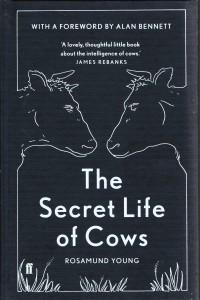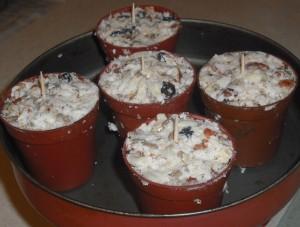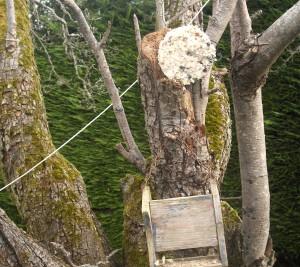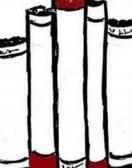As the weather is still tending to be generally less than springlike, I thought that I would revisit my attempts at making fat cakes for our garden bird population. I first had a go at making some back in 2018, inspired by a section in a book that I have on The Landing called The Secret Life of Cows by Rosamund Young. Originally this rather sticky activity featured in a post on the craft blog that I used to write with The Bookworm called, Curiously, Creatively. I thought I would disinter that post from February 2018 and reprint it here (slightly edited) in case you would like to have a go yourselves. All I need to do now is to find some foolproof way of ensuring that the magpies, crows and seagulls (not to mention acrobatic squirrels) don’t charge in and savage the treats before the robins and bluetits get a look-in. Any thoughts?

The immediate prompt for making a feeder (and choosing to make a fat-based feeder) was reading a book that I was given for Hogmanay, The Secret Life of Cows by Rosamund Young (Faber 2017, Farming Books & Videos Ltd, 2003). In amongst all of the cow, sheep and pig stories was an episode about wild bird feeding. The Youngs make winter bird feeders by melting fat, stirring in bread crumbs and moulding the mixture in small plastic cups. I was very taken with their method of fixing the feeders onto canes and putting them in the ground instead of stringing them to hang on a tree. This, I felt I had to attempt for myself.
I used a basic cooking fat (Frytex in this case) from the supermarket and reckoned that trying 100g would give me about the correct amount to fill my two cups. For my mixture I had a root around the kitchen and came up with porridge oats, desiccated coconut, a dried fruit and cashew mix, mixed seeds (pumpkin and sunflower seeds) and some brown soda bread. I didn’t have any cheese, but I figured that if you have a fat base then you don’t really need the fat in the cheese. I used a blend of these ingredients to make up 200g, crumbling up one slice of bread and crushing up the cashews a little before mixing with my melted lard. My mixture just nicely filled the two containers. For the one cup, I made a hole and put string through for hanging. I fixed a wooden spoon in the other to make it easier to fix the cake onto a cane when set. I popped both in the fridge for an hour to set firm.
The final stage was to fix the fat cakes in place in a good spot in the garden. I hung my strung feeder onto the lilac tree, near the old wooden feeder as that spot is familiar to regular bird visitors. In one of last season’s tomato pots, I stuck a long cane and fixed the other cake on to it (after removing wooden spoon!). I did push a bit too hard and the cane came through the end slightly, so I fixed some wooden pegs underneath so the cake wouldn’t slide down the cane. One of our ever-curious resident robin pair came to have a close look at what was going on, while the mate kept a watch from a distance. Then, I retreated to the house to watch for my first proper customers. Perhaps not surprisingly, the blue tits were the first to sample new tuck shop, though the robins were not too far behind. Both these birds managed to get the hang of the feeders very quickly and perched or clung on to feed. These birds have managed to feed from both types of feeder quite easily.
Rosamund Young describes the antics of various species of birds when confronted with a delicious new food source on a stick. Similar to my experience mentioned above, she comments that the blue tits ‘learn how to feed from them within minutes, hanging upside-down with ease.’ Where we differ is in the case of robins, as she notes that it took the robin some time to achieve success. She writes, ‘The best the robin could ever manage was to screw himself into a tight ball on the ground directly under the cup and leap vertically’ until eventually one bird learned to shimmy up the bean pole to feast. Apparently, chaffinches became quite angry with the feeders, but so far, I haven not spotted any in our garden so I am unable to make a comparison. What we do have are greedy starlings however, arriving en masse to hog the food and scare away smaller feeders.
I will just add that this year the birds have peanuts instead of cashew nuts, but I doubt that they will complain too much. I made cakes in mini plant pots and plan to string them up in a holly tree, which is a favoured bluetit haunt in this garden. What I failed to make allowance for was the determination of an acrobatic squirrel making inroads into the bird feed. I tried to film the little critter but couldn’t get a good enough shot. Anyway, it was very entertaining to watch.
That’s all this time, from nature-watch on The Landing Bookshelves!



